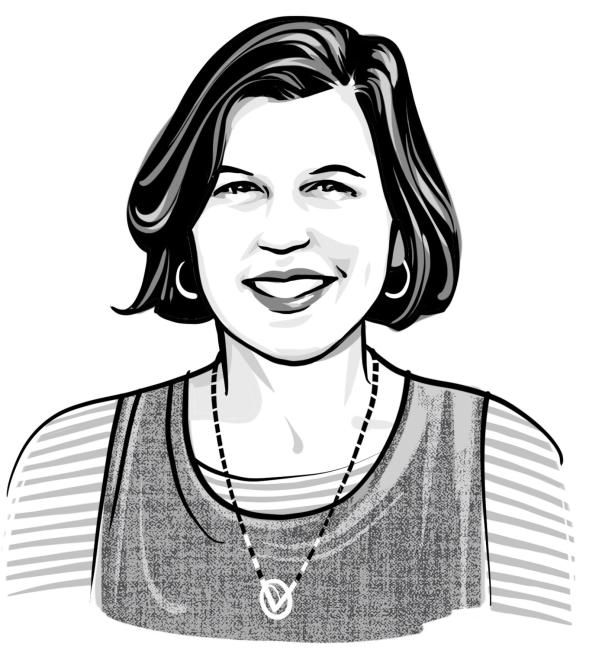April 2024: Handpicked
Each month we ask a member of our staff or a special friend to select favorite stories, books, interviews, or articles from our online collections. This month’s picks are by Margaret Frothingham.

Margaret Frothingham is the Yiddish Book Center’s Translation and Education Program Manager. Among other programs, she coordinates the Translation Fellowship, Bossie Dubowick YiddishSchool, and the Great Jewish Books Summer Program. She holds a BA in studio art and English from Wheaton College in MA and a dual MA/MFA degree in children’s literature and writing for children from Simmons University. Outside of the Center, Margaret works on her own projects as a children’s book author-illustrator.
“Vilde khaye!”: Maurice Sendak’s not-so-cautionary tale
A few months ago, I had the stunning realization that there does not exist (yet!) a biography of one of the greatest picturebook writers of all time, Maurice Sendak. On that same day, I stumbled across this article by Ilan Stavans, hoping there was at least something in our collection about him. His parents most definitely spoke Yiddish—vilde khaye or “wild beast,” was the root inspiration for “wild things”—and I’m so curious to learn more about how the language and culture influenced his work. Stavans’ article does a decent job of highlighting the significance of this book in broader culture and the children’s literature field. I particularly like how he connects Max’s journey to otherness “home and abroad” and the implication that we all, tall or small, have beasts inside.
I really enjoyed this recent “From the Vault” article by Caleb Sher about the life and work of Moyshe Levin, pen named Ber Sarin. The piece, which centers on Levin’s children’s stories, opens like any good children’s book: “I’m going to tell you a story.” Levin’s life story, while tragic, provides insight into how children’s authors navigate social and political upheaval throughout history. I appreciate how Levin, unlike his peers, was determined to publish children’s literature, even if it meant remaining “apolitical.” Perhaps Levin saw the power of kid lit to influence young minds (after all, children’s literature is one of the most common conduits for propaganda). I’d argue there’s no truly apolitical kid’s book and that publishing children’s books that “inspire a love of Yiddish” was radical in itself. Levin’s stories sound so playful and clever—I only wish I could read them!
Yiddish Illustrations: “From Chagall to Diego Rivera”
All of the illustrations highlighted in David Mazower’s “Personal Top Ten” are beautiful, but my favorite is number 6, Majn Alef Bejs. Ula Palusinska’s bold and inventive illustrations jump off the page and wonderfully depict the equally charming poems about the alef beys by Yiddish writer Yeshoshue Kaminski. Abecedarians, a fancy term for picturebooks that teach the alphabet, are best when words and images work together to communicate concepts. I can personally attest to this, having recently learned the Yiddish alphabet myself. Majn Alef Bejs features bilingual Yiddish and Polish text and, given that it was published in 2012, is a beautiful example of contemporary illustration.
Retenishn un shpasn by Sima Dawang
Yiddish education specialist Sonia Bloom read sections of the book Retenishn un shpasn by Sima Dawang aloud at the “Yiddish Storytime” she did during our adult language program, Bossie Dubowick YiddishSchool. I was lucky enough to join her class for the week as a beginner student. Now that I am learning Yiddish, I appreciate children’s books even more as tools for language learning. I adore how seemingly simple this little book is, with its playful illustrations and witty humor.
I found this Pakn Treger article a few years ago after reading Sarah Biskowitz’s thoughtful writeup about Family Snapshots of Yiddish in Cuba. When I saw Ruth Behar’s name pop up in the suggested content, I knew I had to check it out. During the pandemic, when I worked in the Center’s onsite museum store, I read Lucky Broken Girl, a beautiful children’s book by Ruth Behar about a Cuban-Jewish immigrant who learns about her own identity and heritage while convalescing after a horrible accident. Behar’s writing is rich and deeply personal. As a reader it’s easy to feel her sense of longing and her struggle to define home. “A Room Named Ruth” helped me understand more about the history of Jews in Cuba and the complex nature of multicultural identity.
Q&A
Tell us about your selections and what they say about your relationship with Yiddish language and culture.
If it isn’t apparent by my selections, I’m a big fan of children’s books. It was fun to combine my interests in children’s literature with my work here at the Center. For so long, not knowing Yiddish felt like a barrier to understanding our collection. Now that I’m learning Yiddish, it feels like a whole new world of children’s books has opened up to me. Language learning is obviously very humbling, and in many ways you must learn to be a child again—to stay open, curious, and be okay with looking foolish and making mistakes. One of my main arguments about children’s books is that they aren’t necessarily books for children; they are dynamic art forms that can be enjoyed by people of all ages. It is wonderful to see that concept play out in the classroom. I look forward to seeing what Yiddish children’s books can teach me about Yiddish language, history, and culture.
What are you working on next?
Summer education programs start in full swing in June, and I’m busy planning the next Translation Workshop and the Great Jewish Books Program for high school students. Outside of work I rotate between various creative projects but am currently focusing on a nonfiction picturebook about the first ladies.
